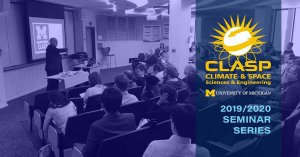Presented By: Climate and Space Sciences and Engineering
<<CANCELED>> CLASP Seminar Series: Dr. Lee Murray, University of Rochester

*NOTE: we regret that this week's seminar with Dr. Murray has been canceled. To protect the health and safety of our communities and minimize the spread of the Novel Coronavirus COVID19, U-M is making changes to classes and events on our Ann Arbor, Dearborn, and Flint campuses.
For more information about the U-M response to COVID-19, please visit https://publicaffairs.vpcomm.umich.edu/2019-novel-coronavirus-covid-19/
We are very pleased to welcome Dr. Lee Murray of the University of Rochester as part of the CLASP Seminar Series.
Dr. Murray will give a lecture titled "Coupling of atmospheric chemistry with global climate across multiple time scales."
Abstract: The reactive chemistry of the atmosphere has changed substantially over time due to human activity and natural processes. In turn, climate change has influenced atmospheric composition through perturbations of natural processes, leading to complex feedbacks across a range of spatial and temporal scales. Here, I present some ongoing projects aimed at characterizing the interface between atmospheric chemistry and Earth’s climate system in the past, present and future. First, I explore the coupling between the primary atmospheric oxidants OH and ozone with the production of reactive nitrogen oxides (NOx) from lightning, and the subsequent impacts on surface air quality and long-term climate. Second, I explore how uncertainty in reactive nitrogen chemistry and hydrocarbon oxidation mechanisms in the atmosphere contribute to uncertainties in chemistry-climate feedbacks, and ongoing efforts to evaluate these processes in global models through the ongoing NASA Atmospheric Tomography airborne mission. Lastly, I introduce a pilot monitoring network and inverse modeling framework for methane, the most abundant atmospheric hydrocarbon and potent greenhouse gas, that is presently being installed to aid New York State in assessing and meeting its greenhouse-gas reduction goals.
Please join us!
For more information about the U-M response to COVID-19, please visit https://publicaffairs.vpcomm.umich.edu/2019-novel-coronavirus-covid-19/
We are very pleased to welcome Dr. Lee Murray of the University of Rochester as part of the CLASP Seminar Series.
Dr. Murray will give a lecture titled "Coupling of atmospheric chemistry with global climate across multiple time scales."
Abstract: The reactive chemistry of the atmosphere has changed substantially over time due to human activity and natural processes. In turn, climate change has influenced atmospheric composition through perturbations of natural processes, leading to complex feedbacks across a range of spatial and temporal scales. Here, I present some ongoing projects aimed at characterizing the interface between atmospheric chemistry and Earth’s climate system in the past, present and future. First, I explore the coupling between the primary atmospheric oxidants OH and ozone with the production of reactive nitrogen oxides (NOx) from lightning, and the subsequent impacts on surface air quality and long-term climate. Second, I explore how uncertainty in reactive nitrogen chemistry and hydrocarbon oxidation mechanisms in the atmosphere contribute to uncertainties in chemistry-climate feedbacks, and ongoing efforts to evaluate these processes in global models through the ongoing NASA Atmospheric Tomography airborne mission. Lastly, I introduce a pilot monitoring network and inverse modeling framework for methane, the most abundant atmospheric hydrocarbon and potent greenhouse gas, that is presently being installed to aid New York State in assessing and meeting its greenhouse-gas reduction goals.
Please join us!